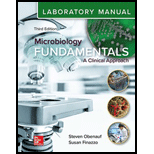
Laboratory Manual for Microbiology Fundamentals: A Clinical Approach
3rd Edition
ISBN: 9781260163469
Author: OBENAUF, Steven
Publisher: MCGRAW-HILL HIGHER EDUCATION
expand_more
expand_more
format_list_bulleted
Concept explainers
Question
Chapter 21.1, Problem 2AYP
Summary Introduction
To enlist:
The natural defenses present in the genitourinary tracts.
Concept introduction:
Genitourinary system consists of two different systems that are urinary system and genital system. Urinary system is involved in the production and excretion of urine and genital system is involved in reproduction. Genitourinary system is also called as urogenital system or urogenital tract.
Expert Solution & Answer
Want to see the full answer?
Check out a sample textbook solution
Students have asked these similar questions
What is the structure and function of Eukaryotic cells, including their organelles? How are Eukaryotic cells different than Prokaryotic cells, in terms of evolution which form of the cell might have came first? How do Eukaryotic cells become malignant (cancerous)?
What are the roles of DNA and proteins inside of the cell? What are the building blocks or molecular components of the DNA and proteins? How are proteins produced within the cell? What connection is there between DNA, proteins, and the cell cycle? What is the relationship between DNA, proteins, and Cancer?
Why cells go through various types of cell division and how eukaryotic cells control cell growth through the cell cycle control system?
Chapter 21 Solutions
Laboratory Manual for Microbiology Fundamentals: A Clinical Approach
Ch. 21.1 - Prob. 1AYPCh. 21.1 - Prob. 2AYPCh. 21.2 - Prob. 3AYPCh. 21.3 - List the possible causative agents, modes of...Ch. 21.3 - Discuss important features of leptospirosis.Ch. 21.3 - Prob. 1NPCh. 21.3 - Medical Moment Cranberry versus UTI It has long...Ch. 21.4 - List the possible causative agents, modes of...Ch. 21.4 - Prob. 7AYPCh. 21.4 - Prob. 8AYP
Ch. 21.4 - Prob. 9AYPCh. 21.4 - Prob. 10AYPCh. 21.4 - Prob. 11AYPCh. 21.4 - Prob. 12AYPCh. 21.4 - Prob. 2NPCh. 21.4 - Prob. 3NPCh. 21.4 - Prob. 2MMCh. 21 - Prob. 1QCh. 21 - Some of the E. coli strains that are normal biota...Ch. 21 - Many STIs are asymptomatic, or remain latent for...Ch. 21 - Prob. 4QCh. 21 - Three microorganisms in this chapter can be...Ch. 21 - Prob. 6QCh. 21 - Prob. 7QCh. 21 - Prob. 8QCh. 21 - Prob. 9QCh. 21 - Prob. 10QCh. 21 - Prob. 11QCh. 21 - Prob. 12QCh. 21 - Prob. 13QCh. 21 - Prob. 14QCh. 21 - Prob. 15QCh. 21 - Prob. 16QCh. 21 - Prob. 17QCh. 21 - Prob. 18QCh. 21 - Prob. 19QCh. 21 - Prob. 20QCh. 21 - Prob. 21QCh. 21 - Prob. 1VC
Knowledge Booster
Learn more about
Need a deep-dive on the concept behind this application? Look no further. Learn more about this topic, biology and related others by exploring similar questions and additional content below.Similar questions
- In one paragraph show how atoms and they're structure are related to the structure of dna and proteins. Talk about what atoms are. what they're made of, why chemical bonding is important to DNA?arrow_forwardWhat are the structure and properties of atoms and chemical bonds (especially how they relate to DNA and proteins).arrow_forwardThe Sentinel Cell: Nature’s Answer to Cancer?arrow_forward
- Molecular Biology Question You are working to characterize a novel protein in mice. Analysis shows that high levels of the primary transcript that codes for this protein are found in tissue from the brain, muscle, liver, and pancreas. However, an antibody that recognizes the C-terminal portion of the protein indicates that the protein is present in brain, muscle, and liver, but not in the pancreas. What is the most likely explanation for this result?arrow_forwardMolecular Biology Explain/discuss how “slow stop” and “quick/fast stop” mutants wereused to identify different protein involved in DNA replication in E. coli.arrow_forwardMolecular Biology Question A gene that codes for a protein was removed from a eukaryotic cell and inserted into a prokaryotic cell. Although the gene was successfully transcribed and translated, it produced a different protein than it produced in the eukaryotic cell. What is the most likely explanation?arrow_forward
- Molecular Biology LIST three characteristics of origins of replicationarrow_forwardMolecular Biology Question Please help. Thank you For E coli DNA polymerase III, give the structure and function of the b-clamp sub-complex. Describe how the structure of this sub-complex is important for it’s function.arrow_forwardMolecular Biology LIST three characteristics of DNA Polymerasesarrow_forward
arrow_back_ios
SEE MORE QUESTIONS
arrow_forward_ios
Recommended textbooks for you
 Medical Terminology for Health Professions, Spira...Health & NutritionISBN:9781305634350Author:Ann Ehrlich, Carol L. Schroeder, Laura Ehrlich, Katrina A. SchroederPublisher:Cengage Learning
Medical Terminology for Health Professions, Spira...Health & NutritionISBN:9781305634350Author:Ann Ehrlich, Carol L. Schroeder, Laura Ehrlich, Katrina A. SchroederPublisher:Cengage Learning Human Biology (MindTap Course List)BiologyISBN:9781305112100Author:Cecie Starr, Beverly McMillanPublisher:Cengage Learning
Human Biology (MindTap Course List)BiologyISBN:9781305112100Author:Cecie Starr, Beverly McMillanPublisher:Cengage Learning


Medical Terminology for Health Professions, Spira...
Health & Nutrition
ISBN:9781305634350
Author:Ann Ehrlich, Carol L. Schroeder, Laura Ehrlich, Katrina A. Schroeder
Publisher:Cengage Learning



Human Biology (MindTap Course List)
Biology
ISBN:9781305112100
Author:Cecie Starr, Beverly McMillan
Publisher:Cengage Learning

12DaysinMarch, Genital Infections for USMLE Step One; Author: Howard Sachs;https://www.youtube.com/watch?v=66zR_FypVFQ;License: Standard youtube license